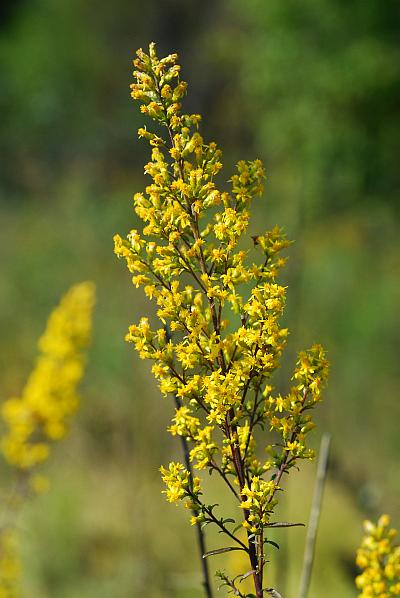Solidago speciosa Nutt.
Prairie Goldenrod

Native
CC = 7
CW = 5
MOC = 45
© SRTurner
Solidago speciosa Nutt.Prairie Goldenrod | |
 |
Native CC = 7 CW = 5 MOC = 45 |
© SRTurner |
|
Family - Asteraceae/Astereae Habit - Perennial herb with short, stout rootstock. Usually not rhizomatous. Stems - Erect, to 1.5 m, finely ridged, glabrous below the inflorescence, not glaucous.
Leaves - Alternate, basally disposed or with the largest leaves about 1/3 way up the stem, sometimes with offshoots present. Blades to 30 cm long, mostly 2-6 times as long as wide, elliptic, somewhat thickened, tapered at the base, margins entire or shallowly toothed, glabrous, the underside with 1 main vein.
Inflorescences - Axillary clusters or racemes, these usually appearing as a racemose, elongate terminal panicle (this not pyramidal or nodding), the heads oriented in several directions when ascending to spreading branches are present.
Heads - Involucre 3-6 mm long, the bracts in 3-5 unequal series. Involucral bracts mostly oblong, rounded or bluntly pointed at the appressed-ascending tip. Receptacle naked. Ray florets 5-8, the corollas 3.5-5.0 mm long, yellow. Disc florets 7-10, the corollas 2-4 mm long, the lobes 0.5-0.9 mm long, yellow. Pappus bristles 2.0-3.5 mm long..
Fruits - Fruits 1.0-1.8 mm long, narrowly obovoid, glabrous. Flowering - August - November. Habitat - Prairies, loess hills, savannas, bluff tops, forest openings. Origin - Native to the U.S. Lookalikes - Other species of Solidago. Other info. - This attractive species is found in scattered locations throughout much of the state, usually in upland habitats. Its North American distribution includes the eastern half of the U.S. and upward into parts of Canada. Various authors have described infraspecific forms of the plant, two of which (var. rigidiuscula and var. speciosa) are currently recognized in Missouri. These differ primarily in leaf width and overall height of the plant. The species epithet speciosa means "beautiful." Photographs taken at Shaw Nature Reserve, Franklin County, MO, 9-28-2018 (SRTurner). |